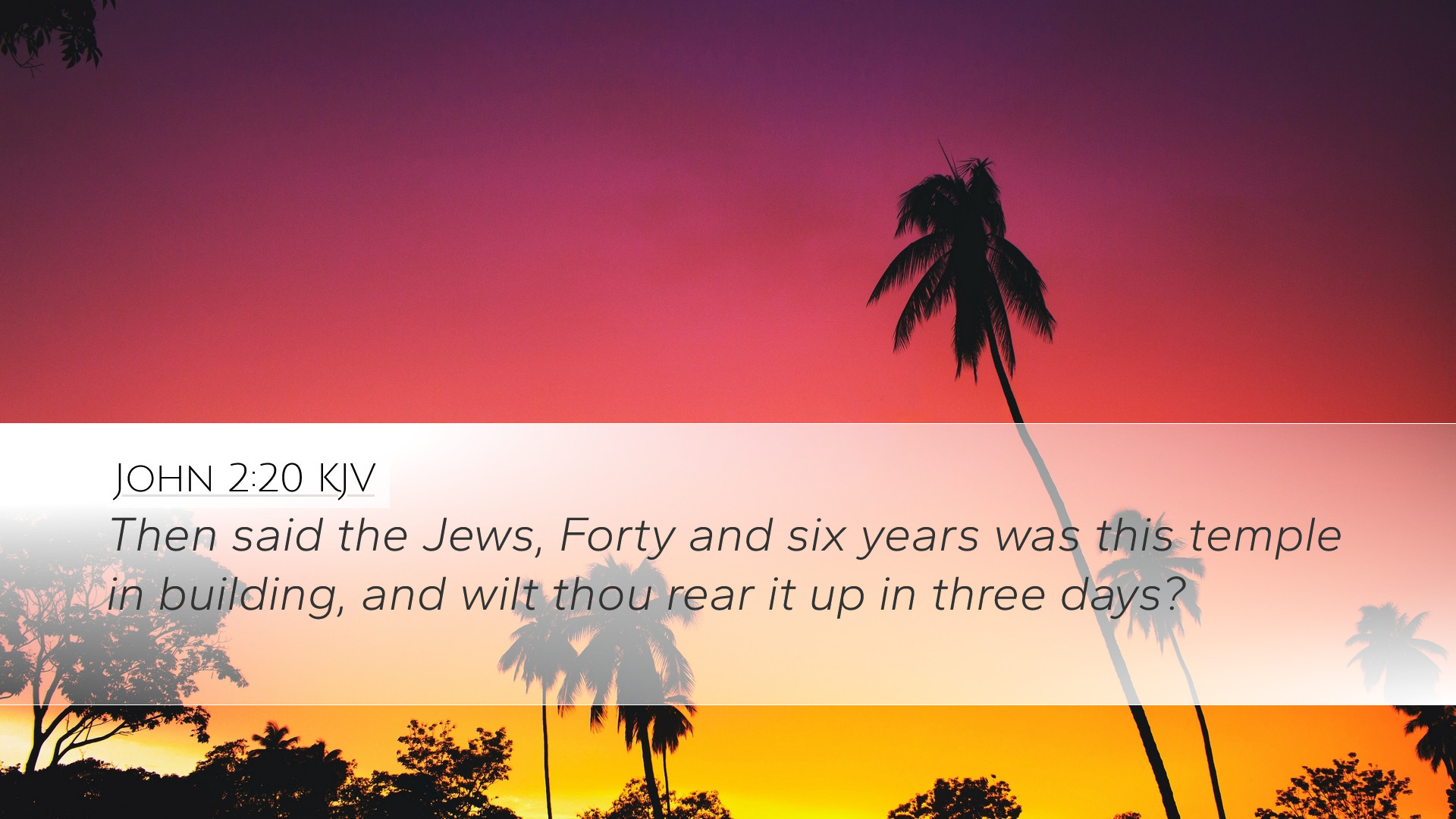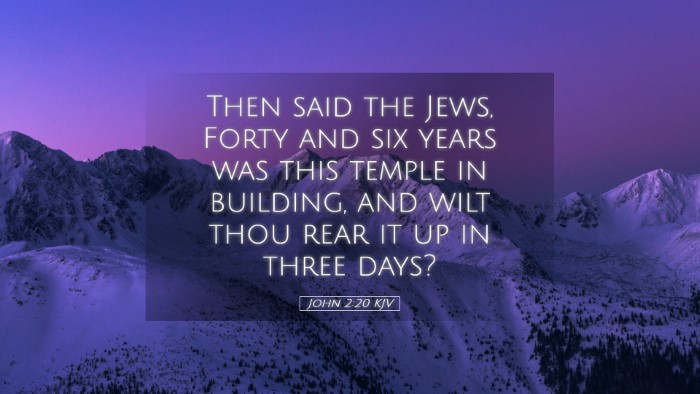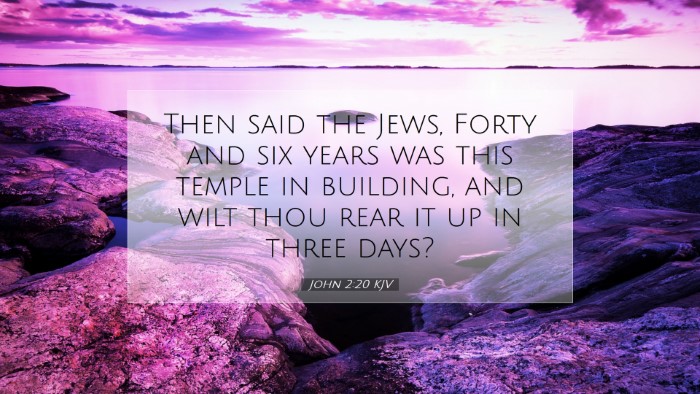Old Testament
Genesis Exodus Leviticus Numbers Deuteronomy Joshua Judges Ruth 1 Samuel 2 Samuel 1 Kings 2 Kings 1 Chronicles 2 Chronicles Ezra Nehemiah Esther Job Psalms Proverbs Ecclesiastes Song of Solomon Isaiah Jeremiah Lamentations Ezekiel Daniel Hosea Joel Amos Obadiah Jonah Micah Nahum Habakkuk Zephaniah Haggai Zechariah MalachiJohn 2:20
John 2:20 KJV
Then said the Jews, Forty and six years was this temple in building, and wilt thou rear it up in three days?
John 2:20 Bible Commentary
Commentary on John 2:20
Verse Analysis: John 2:20 states, "Then said the Jews, Forty and six years was this temple in building, and wilt thou rear it up in three days?" This verse occurs in the context of Jesus' cleansing of the temple and His subsequent prophecy regarding the destruction and resurrection of His body.
Contextual Background
To fully understand John 2:20, one must consider the broader narrative of the Gospel of John. This occurrence follows Jesus’ miraculous signs and the Passover festival. The Jews are incredulous at Jesus’ assertion about the temple, reflecting their literal interpretation of His words.
The significance of the temple in Jewish tradition cannot be understated. It was a symbol of God’s presence among His people, and its construction was an arduous process that spanned nearly half a century. Thus, the Jews' response demonstrates their attachment to the physical structure rather than an understanding of the spiritual reality that Jesus was conveying.
Insight from Matthew Henry
Matthew Henry, in his commentary, emphasizes the irony of the Jews’ misunderstanding. He highlights that while they prided themselves on the physical temple, they failed to recognize that Jesus Himself is the true temple where God dwells among men. Henry expounds on the significance of Jesus' body as the new temple, which would be raised in three days after His crucifixion, thus fulfilling the typology of the temple.
He notes, "They look at that which is visible and external, while he speaks of that which is internal and spiritual." This comment serves to challenge readers to reconsider their own understanding of the sacred versus the mundane, reminding them that true worship transcends physical locations.
Insights from Albert Barnes
Albert Barnes provides an exegetical analysis of the significance of the temple's destruction and restoration. He elaborates on how the Jews were fixated on their historical construct, which represented their covenant relationship with God. Barnes elaborates that the temple was not merely a building; it was a covenantal sign that pointed to something greater to come—the Messiah.
He states, "The temple was not an end in itself, but a type of Christ." This underscores a key theological point that the physical and spiritual realms are intimately connected in the narrative of redemption—a theme that resonates throughout Jewish history and culminates in the person of Christ.
Adam Clarke's Perspective
Adam Clarke's commentary draws attention to the timeframe mentioned in the verse—the forty-six years of construction of the temple. He points out that this period signifies the dedication and labor the Jews had invested in their physical temple, a structure adorned with glory and significant historical value.
Clarke emphasizes that the Jews’ response signifies a stark contrast between their physical devotion and the spiritual truth presented by Christ. He alludes to the profound misunderstanding that prevails when spiritual truths are communicated through metaphorical language. Clarke concludes that this misunderstanding sets the stage for the broader conflict between Jesus and the religious authorities, which ultimately leads to His crucifixion.
Thematic Reflections
- Physical vs. Spiritual Worship: This passage raises important questions about the nature of worship. Are we, like the Jews, too focused on physical manifestations of faith, or are we able to grasp the spiritual realities that they represent?
- Christ as the New Temple: The transition from the physical temple to Christ as the temple signifies a profound theological shift. Believers are invited into a relationship with God that does not depend upon sacred spaces but rather on a living relationship with Jesus.
- Prophetic Fulfillment: Jesus’ prophecy relating to His resurrection foreshadows the ultimate victory over death and the restoration of humanity’s relationship with God.
- Misunderstanding of Truth: The reaction of the Jews serves as a reminder that spiritual understanding often requires divine insight and revelation. Their lack of understanding reflects a broader human condition still present today.
Conclusion
John 2:20 serves as a pivotal moment in the Gospel narrative, challenging readers to consider the implications of Jesus' identity as the true temple. Through the insights of Matthew Henry, Albert Barnes, and Adam Clarke, we discover the layers of meaning embedded within this verse, as it encapsulates the tension between physical devotion and spiritual reality. The commentary illustrates that true worship is not confined to a location; rather, it is found in the person of Jesus Christ, who embodies the ultimate revelation of God to humanity.


